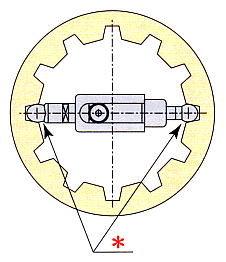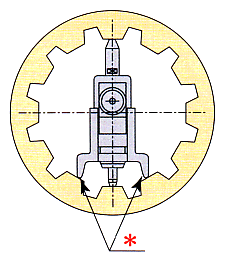For Peacock, measuring unusual places and shapes is never impossible.
- Using specified ball diameters on both ends, we custom-manufacture dial bore gauges for measuring pitch diameter.
- For measuring root diameter, we remove the contact point guides (centering mechanism) so the gauges will not touch either gear tooth flank.
- For measuring the inside diameter, we add contact point guides (centering mechanism) to support the gauges on top of the gear teeth.
Measuring Pitch Diameter
| Please specify pitch diameter and ball diameter. (Carbide material will be used for all balls if not specified. For very unique requirements, we some- times ask customers to supply us their own gauge balls.) |
When gauge balls interfere with tooth surface and invalidate the measurement, we truncate both balls. |
We provide customized conversion tables for applications with odd numbered teeth. (Individual conversion table is made just for your application.) |
 * The diameter of these balls is a key point. |
 * Both ball ends are truncated. |
 |
Measuring Large Diameter
| Please specify large diameter (ø D), width and height of face. (We design contact points that do not touch either gear surface.) |
When the number of teeth are odd, one side of the contact point is bifurcated to straddle a tooth. |
 * Dimensioned the size of contact point |
 * Contact points straddle a tooth |
Measuring Small Diameter
| Please specify inside diameter size and whole depth of tooth. (We design contact point guides on both sides of contact point.) |
Ball tip is used on contact point guides. |
|
|
 * Putting contact point guides against the top of the teeth is the key. |
 * Ball tips avoid friction wear |
For Inquiries:
We provide quotes based on submitted workpiece drawings or actual workpiece examples. There is no minimum quantity required.
Please specify what you want to measure, workpiece materials and tolerance.



















